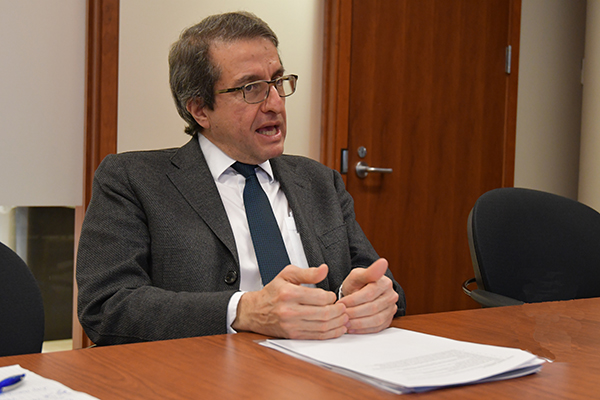Team Canada approach to research
March 5, 2020
Share
Alejandro Adem, the newly-minted president of the Natural Sciences and Engineering Research Council of Canada (NSERC) recently visited Queen’s University where he met with students and NSERC-funded researchers to discover how NSERC funding is helping to advance research at the university. He also sat down with the Queen's Gazette to talk about the Canadian research funding landscape, research promotion, and future priorities for research in Canada.

Q: As the new president, what do you see as the biggest opportunities for NSERC over the next five years?
A: The biggest opportunity is a specific focus on getting young people, early career researchers, and post docs excited about science and engineering, and making sure we fund the best and the most impactful projects.
Q: What do you think Canada needs to do to improve its international research competitiveness and reputation?
A: Different organizations that fund science and research must work much more closely together. The whole idea of “Team Canada” when it comes to science and engineering research, and, in fact, across all sciences, is extremely important. There have been some steps in that direction, including the Canada Research Coordinating Committee assembled by the government over the last three years. We should be working together because the kinds of investments that each specific agency can make do not compare with the worldwide competition. So, being able to work together and leverage against each other will give the Canadian research ecosystem much more impact and scope.
Q: NSERC is leading the Dimensions EDI program, and leading the way for equity, diversity, and inclusivity in the research environment broadly. Collectively, what are we, as a national research community, doing well? How can we continue to grow and learn?
A: Our research community is very open to understanding that things must change, and that we cannot be doing business as usual. They’ve been very receptive around the idea of diversity and inclusion as fundamental aspects of how we evaluate science, how we do science, how universities operate, and how grants are adjudicated and dispersed. What we need to do more of is figuring out how to achieve the goals and aspirations the Dimensions EDI program charter postulates. People need practical advice, coaching, and support, so we have created communities of learners working on that; working to create a system designed to develop best practices. In the future, that knowledge can be shared and built into the system.
Q: On your visit to Queen’s University you met with several different researcher groups representing different fields – from the creative arts and humanities to the health sciences and engineering. What does the future look like for interdisciplinary research in Canada?
A: The future is very bright because we have very strong disciplinary research in Canada, and that’s very important. You really want to have a depth of knowledge to start with. At the same time, we have universities and funding systems that have realized they have to create incentives and mechanisms for interdisciplinary connections. One of NSERC’s goals will be to provide new funding opportunities that can support interdisciplinary research from its inception.
Q: What did you learn about the research happening at Queen’s? How does it align with the future vision of NSERC?
A: I learned that you have an extremely dynamic group of researchers in a variety of areas that are important to NSERC. It’s clear to me there is a strong expertise here, a very high level in science and engineering. I also had the opportunity to meet with a group of students – a very dynamic, diverse, and engaged group. The level of engagement at Queen’s is phenomenal.
Q: Final thoughts?
Did you know that the university recently launched a new central website for Queen’s research? From in-depth features to the latest information on the university’s researchers, the site is a destination showcasing the impact of Queen’s research. Discover Research@Queen’s.
A: I had the opportunity to attend an award event for Science Rendezvous Kingston where coordinators Lynda Colgan and Kim Garrett received recognition as the best Science Rendezvous event in the country. It’s outstanding work that team has done.
Promoting science is one of our top priorities and we need the public to understand science and engineering. This will translate into what the decision makers understand about science. I take back with me that Queen’s is engaged on the research side, in training, working with students, and also the research promotion side. This is rare to see.